Page 54 of 267
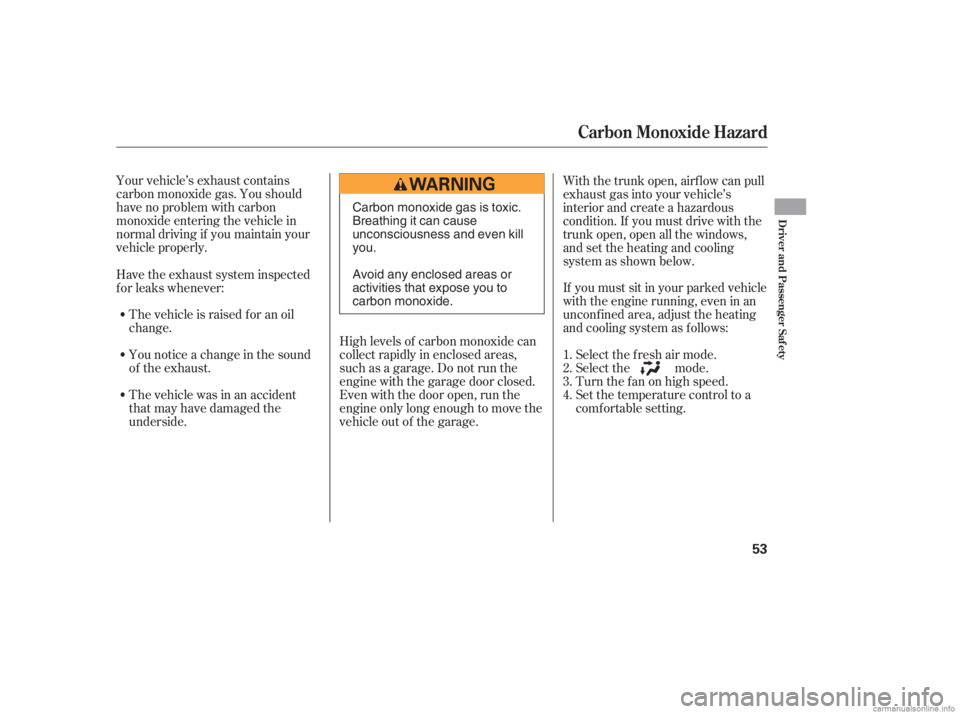
Your vehicle’s exhaust contains
carbon monoxide gas. You should
have no problem with carbon
monoxide entering the vehicle in
normal driving if you maintain your
vehicle properly.High levels of carbon monoxide can
collect rapidly in enclosed areas,
such as a garage. Do not run the
engine with the garage door closed.
Even with the door open, run the
engine only long enough to move the
vehicle out of the garage.If you must sit in your parked vehicle
with the engine running, even in an
unconf ined area, adjust the heating
and cooling system as f ollows:
Select the f resh air mode.
Select the mode.
Turn the f an on high speed.
Set the temperature control to a
comfortable setting.
With the trunk open, airf low can pull
exhaust gas into your vehicle’s
interior and create a hazardous
condition. If you must drive with the
trunk open, open all the windows,
and set the heating and cooling
system as shown below.
Have the exhaust system inspected
f or leaks whenever:
The vehicle is raised f or an oil
change.
You notice a change in the sound
of the exhaust.
The vehicle was in an accident
that may have damaged the
underside. 1.
2.
3.
4.
Carbon Monoxide Hazard
Driver and Passenger Saf ety
53
Carbon monoxide gas is toxic.
Breathing it can cause
unconsciousness and even kill
you.
Avoid any enclosed areas or
activities that expose you to
carbon monoxide.
�����—�����—�����y�
����
��������y���
�(�#���������y���������y
Page 150 of 267
Bef ore you begin driving your
vehicle, you should know what
gasoline to use and how to check the
levels of important f luids. You also
need to know how to properly store
luggage or packages. The
inf ormation in this section will help
you. If you plan to add any
accessories to your vehicle, please
read the information in this section
first..............................
Break-in Period .150
.................
Fuel Recommendation .150
.........
Service Station Procedures .151
....................................
Ref ueling .151
Opening and Closing the
.......................................
Hood .152
...................................
Oil Check .153
.............
Engine Coolant Check .154
...............................
Fuel Economy .154
...
Accessories and Modif ications .155
.............................
Carrying Cargo .157
Bef ore Driving
Bef ore Driving
149
�����—�����—�����y�
���������
�
�y���
�(�#���������y���
�����y
Page 154 of 267
Remove the dipstick again, and
check the level. It should be
between the upper and lower
marks.
Wait a f ew minutes af ter turning the
engine of f bef ore you check the oil.
Remove the dipstick (orange loop).
Wipe the dipstick with a clean
cloth or paper towel.
Insert it all the way back in its tube.
To close the hood, lif t it up slightly to
remove the support rod f rom the
hole. Put the support rod back into
its holding clip. Lower the hood to
about a f oot (30 cm) above the
f ender, then let it drop. Make sure it
is securely latched.
If it is near or below the lower mark,
see on page .
2.
3. 1. 4.
191
Service Station Procedures
Oil Check
A dding Engine Oil
Bef ore Driving
153
DIPSTICK UPPER MARK
LOWER MARK
SUPPORT ROD
CLIP GRIP
�����—�����—�����y�
�������������y���
�(�#���������y���
�����y
Page 187 of 267
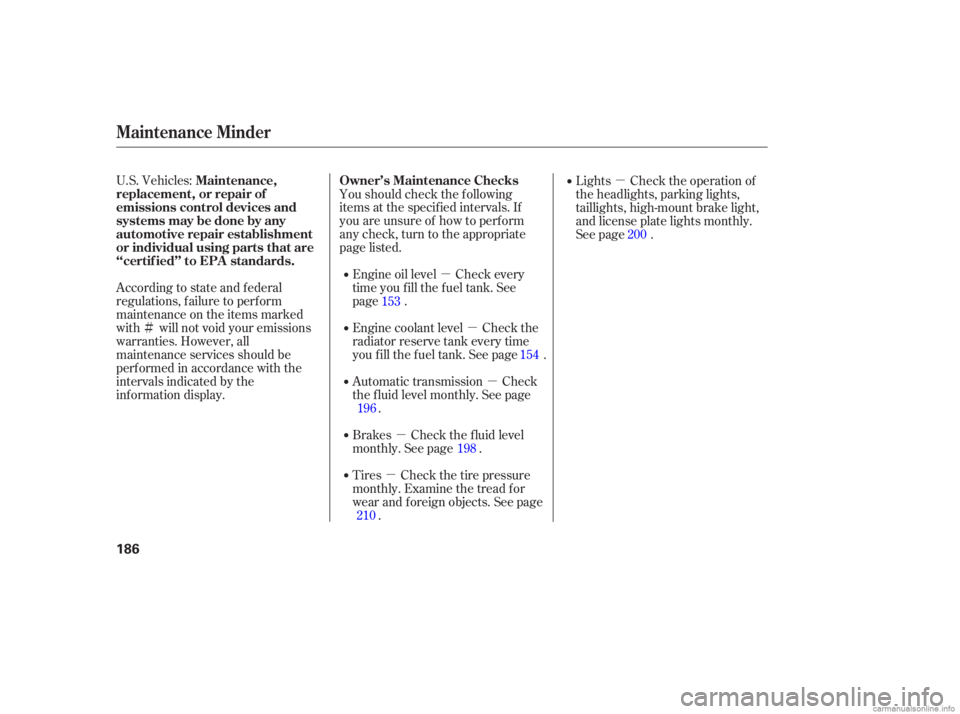
�Ì�µ
�µ�µ
�µ
�µ �µ
U.S. Vehicles:
According to state and federal
regulations, f ailure to perf orm
maintenance on the items marked
with will not void your emissions
warranties. However, all
maintenance services should be
perf ormed in accordance with the
intervals indicated by the
inf ormation display. Youshouldcheckthefollowing
items at the specif ied intervals. If
you are unsure of how to perf orm
any check, turn to the appropriate
page listed.
Engine oil level Check every
time you fill the fuel tank. See
page .
Engine coolant level Check the
radiator reserve tank every time
you f ill the f uel tank. See page .
Automatic transmission Check
the f luid level monthly. See page .
Brakes Check the f luid level
monthly. See page .
Tires Check the tire pressure
monthly. Examine the tread f or
wear and foreign objects. See page . Lights Check the operation of
the headlights, parking lights,
taillights, high-mount brake light,
and license plate lights monthly.
See page .
153 154
196 198
210 200
Maintenance Minder
Maintenance,
replacement, or repair of
emissions control devices and
systems may be done by any
automotive repair establishment
or individual using parts that are
‘‘certif ied’’ to EPA standards. Owner’s Maintenance Checks
186
�����—�����—�����y�
�����������
�y���
�(�#���������y���
�����y
Page 188 of 267
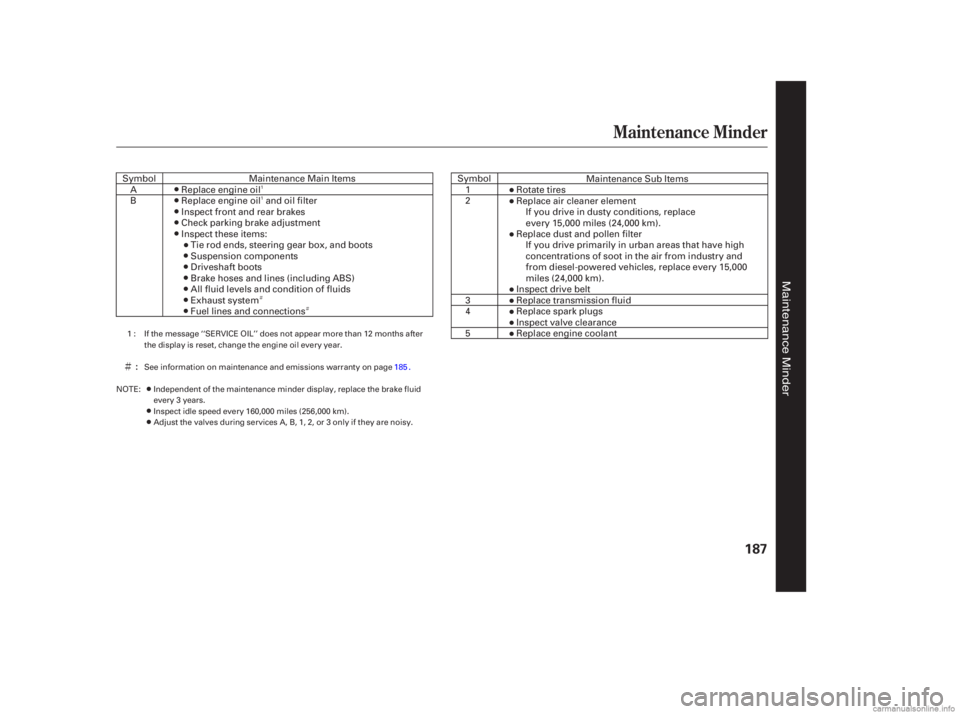
�Ì�Ì
�Ì
Maintenance Minder
187
: Maintenance Sub Items
Rotate tires
Replace air cleaner element If you drive in dusty conditions, replace
every 15,000 miles (24,000 km).
Replace dust and pollen filter If you drive primarily in urban areas that have high
concentrations of soot in the air from industry and
from diesel-powered vehicles, replace every 15,000
miles (24,000 km).
Inspect drive belt
Replace transmission fluid
Replace spark plugs
Inspect valve clearance
Replace engine coolant
Maintenance Main Items
Replace engine oil
Replace engine oil and oil filter
Inspect front and rear brakes
Check parking brake adjustment
Inspect these items: Tie rod ends, steering gear box, and boots
Suspension components
Driveshaft boots
Brake hoses and lines (including ABS)
All fluid levels and condition of fluids
Exhaust system
Fuel lines and connections
A
B
Symbol
Symbol
1
2
3
4
5
If the message ‘‘SERVICE OIL’’ does not appear more than 12 months after
the display is reset, change the engine oil every year.
See information on maintenance and emissions warranty on page.
Independent of the maintenance minder display, replace the brake fluid
every 3 years.
Inspect idle speed every 160,000 miles (256,000 km).
Adjust the valves during services A, B, 1, 2, or 3 only if they are noisy.
NOTE:
185
1:
1
1
Maintenance Minder
�����—�����—�����y�
�������������y���
�(�#���������y���
�����y
Page 192 of 267
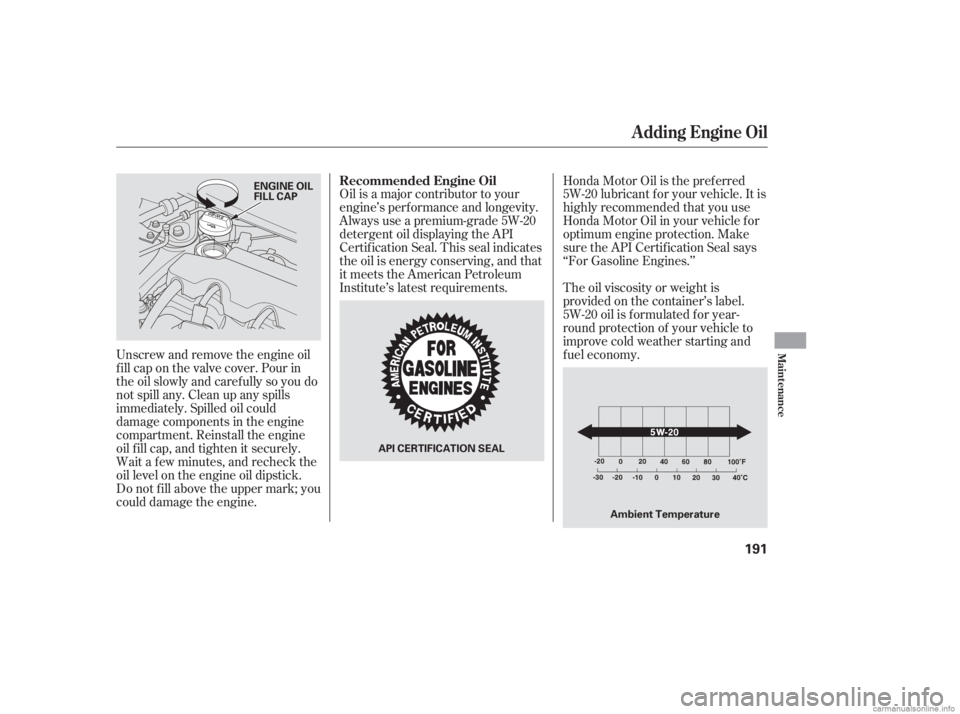
Oil is a major contributor to your
engine’s perf ormance and longevity.
Always use a premium-grade 5W-20
detergent oil displaying the API
Certif ication Seal. This seal indicates
the oil is energy conserving, and that
it meets the American Petroleum
Institute’s latest requirements.Honda Motor Oil is the pref erred
5W-20 lubricant f or your vehicle. It is
highly recommended that you use
Honda Motor Oil in your vehicle f or
optimum engine protection. Make
sure the API Certif ication Seal says
‘‘For Gasoline Engines.’’
The oil viscosity or weight is
provided on the container’s label.
5W-20 oil is f ormulated f or year-
round protection of your vehicle to
improve cold weather starting and
f uel economy.
Unscrew and remove the engine oil
fill cap on the valve cover. Pour in
the oil slowly and caref ully so you do
not spill any. Clean up any spills
immediately. Spilled oil could
damage components in the engine
compartment. Reinstall the engine
oil f ill cap, and tighten it securely.
Wait a f ew minutes, and recheck the
oil level on the engine oil dipstick.
Do not f ill above the upper mark; you
could damage the engine. Recommended Engine Oil
A dding Engine Oil
Maint enance
191
API CERTIFICATION SEAL
ENGINE OIL
FILL CAP
Ambient Temperature
�����—�����—�����y�
�������������y���
�(�#���������y���
�����y
Page 194 of 267
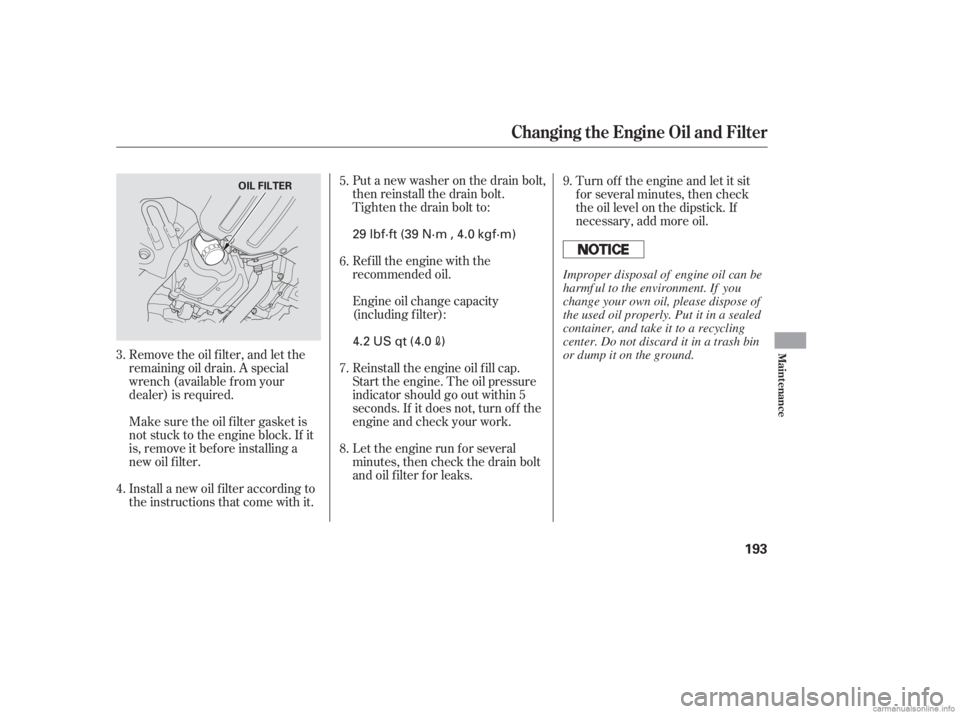
Put a new washer on the drain bolt,
then reinstall the drain bolt.
Tighten the drain bolt to:
Refill the engine with the
recommended oil.
Engine oil change capacity
(including f ilter):
Reinstall the engine oil f ill cap.
Start the engine. The oil pressure
indicator should go out within 5
seconds. If it does not, turn of f the
engine and check your work.
Let the engine run f or several
minutes, then check the drain bolt
and oil f ilter f or leaks.Turn of f the engine and let it sit
f or several minutes, then check
the oil level on the dipstick. If
necessary, add more oil.
Remove the oil f ilter, and let the
remaining oil drain. A special
wrench (available from your
dealer) is required.
Install a new oil f ilter according to
the instructions that come with it. Make sure the oil f ilter gasket is
not stuck to the engine block. If it
is, remove it bef ore installing a
new oil f ilter. 5.
6.
7.
8.
9.
3.
4.
Changing the Engine Oil and Filter
Maint enance
193
OIL FILTER
29 lbf·ft (39 N·m , 4.0 kgf·m)
4.2 US qt (4.0
) Improper disposal of engine oil can be
harmf ul to the environment. If you
change your own oil, please dispose of
the used oil properly. Put it in a sealed
container, and take it to a recycling
center. Do not discard it in a trash bin
or dump it on the ground.
�����—�����—�����y�
�����������
�y���
�(�#���������y���
�����y
Page 198 of 267
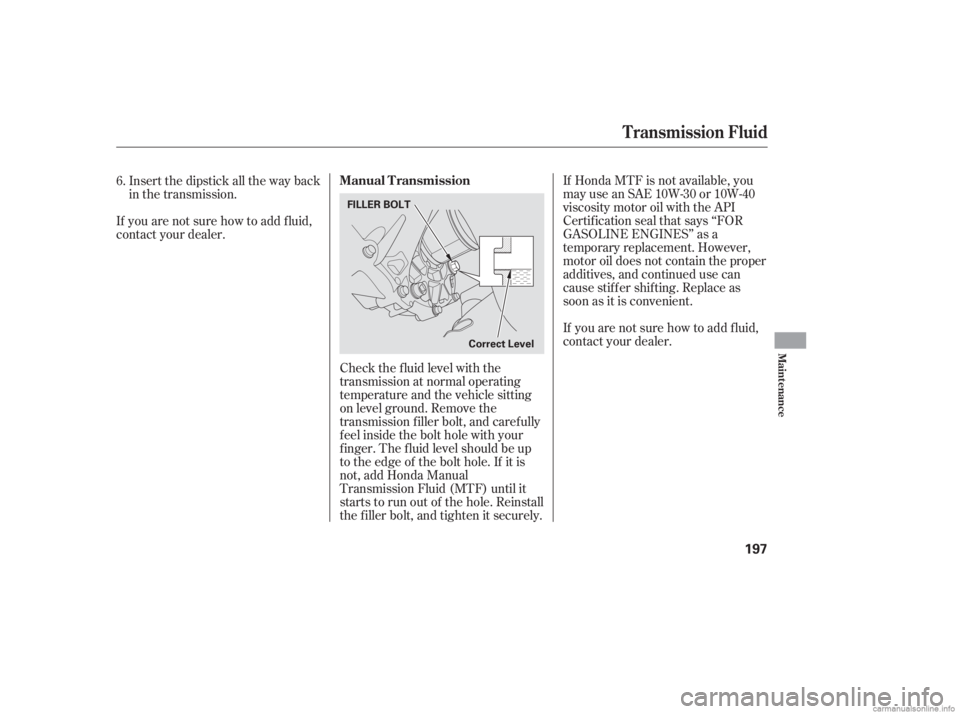
If Honda MTF is not available, you
may use an SAE 10W-30 or 10W-40
viscosity motor oil with the API
Certif ication seal that says ‘‘FOR
GASOLINE ENGINES’’ as a
temporary replacement. However,
motor oil does not contain the proper
additives, and continued use can
cause stif f er shif ting. Replace as
soon as it is convenient.
Check the f luid level with the
transmission at normal operating
temperature and the vehicle sitting
on level ground. Remove the
transmission f iller bolt, and caref ully
f eel inside the bolt hole with your
f inger. The f luid level should be up
to the edge of the bolt hole. If it is
not, add Honda Manual
Transmission Fluid (MTF) until it
starts to run out of the hole. Reinstall
the f iller bolt, and tighten it securely.
Insert the dipstick all the way back
in the transmission.
If you are not sure how to add f luid,
contact your dealer.
If you are not sure how to add f luid,
contact your dealer.
6.
T ransmission Fluid
Manual Transmission
Maint enance
197
FILLER BOLT
Correct Level
�����—�����—�����y�
�������������y���
�(�#���������y���������y